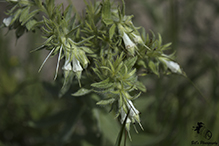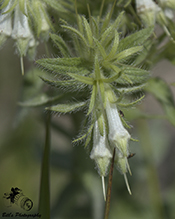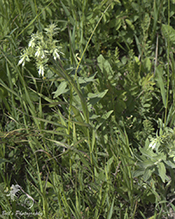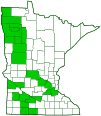softhair marbleseed
(Lithospermum parviflorum)
Conservation • Description • Habitat • Ecology • Use • Distribution • Taxonomy
Conservation Status |
|
|||||||
| IUCN Red List | not listed |
|||||||
| NatureServe | NNR - Unranked SNR - Unranked |
|||||||
| Minnesota | not listed |
|||||||
Description |
||
Softhair marbleseed is a 12″ to 48″ tall, erect or ascending, perennial forb that rises on several stems from a stout, woody root. The stems are erect, and leafy. They often have a few branches above the middle. They are moderately to densely covered with spreading, short and long hairs. Basal leaves are absent and lower leaves withered or absent by the time the plant is in flower.Stem leaves are alternate, stalkless, unlobed, and untoothed. The leaf blades are lance-shaped to narrowly egg-shaped, ¾″ to 5½″long, and ½″ to 1½″ wide. They are angled or tapered at the base and angled or tapered to a sharp point at the tip. There is a midvein and 2 or 3 pairs of lateral veins that curve toward the leaf tip. The veins are strongly recessed on the upper surface, strongly raised on the lower surface. The upper leaf surface is densely covered with more or less spreading hairs, some of them longer and some shorter. The lower surface is moderately to densely covered with softer hairs, some of them longer and some shorter. The inflorescence is a crowded, one-sided, coiled, unbranched, spike-like cluster (raceme) at the ends of the stem and branches. The shape of the raceme resembles a scorpion’s tail. The flowers are ⅓″ to ⅔″ long, 1½ to 2 times as long as wide, and tubular-shaped, converging to a point near the tip with straight sides along the tip. The 5 petals are dull white or greenish white and hairy. The style protrudes from the floral tube. These flowers mature reproductively well before the petals are developed. The fruit is a white, smooth, dull, marble-like, 1 ⁄16″ to ⅛″ (2.5 to 3 mm) in diameter nutlet. It is flared at the base into a small collar around the attachment point. It remains on the plant throughout the winter. |
||
Height |
||
12″ to 48″ |
||
Flower Color |
||
Dull white or greenish white |
||
Similar Species |
||
Western marbleseed (Lithospermum occidentale) is the western species. It is a shorter plant, reaching only 28″ in height. The leaves are much smaller, no more than 3⅛″ long and ¾″ wide. The nutlet is shiny and over ⅛″ in diameter. It does not have a collar around the attachment point. |
||
Habitat |
||
Moderately dry. Prairies, open woods. Full sun. |
||
Ecology |
||
Flowering |
||
June to July |
||
Pests and Diseases |
||
|
||
Use |
||
|
||
Distribution |
||||
|
Sources |
|||
| 6/18/2023 | ||||
Nativity |
||||
Native |
||||
Occurrence |
||||
|
||||
Taxonomy |
|||||||||||||||||||
| Kingdom | Plantae (Plants) | ||||||||||||||||||
| Division | Tracheophyta (Vascular Plants) | ||||||||||||||||||
| Subdivision | Spermatophytina (Seed Plants) | ||||||||||||||||||
| Class | Magnoliopsida (Dicots) | ||||||||||||||||||
Order |
Boraginales (borages) | ||||||||||||||||||
Family |
Boraginaceae (borage) | ||||||||||||||||||
| Subfamily | Boraginoideae | ||||||||||||||||||
| Tribe | Lithospermeae | ||||||||||||||||||
Genus |
Lithospermum (stoneseeds, puccoons, and gromwells) | ||||||||||||||||||
The nomenclature for this species has been in flux for more than two decades. It was originally listed as Onosmodium molle ssp. hispidissimum. In 1995 it was renamed Onosmodium bejariense var. hispidissimum (Turner, 1995). In 2009, based on a reassessment of DNA data, all of the species in the genus Onosmodium and four other genera were transferred to the genus Lithospermum. This subspecies, along with ssp. occidentale (western marbleseed), became synonyms of Lithospermum onosmodium. In December, 2011, the former subspecies of Onosmodium bejariense were raised to specific rank (Cohen and Davis, 2011). The new name of this species, complete with author, is Lithospermum parviflorum Weakley, Witsell & D. Estes. The following reputable and current (online) sources are not in agreement regarding the scientific name for this plant as of this writing (6/18/2023). |
|||||||||||||||||||
|
|||||||||||||||||||
The name Lithospermum parviflorum, used on MinnesotaSeasons.com, is from Weakley, et al (see Source below), the source of the most recent taxonomic revision. |
|||||||||||||||||||
---------------------------------------------- |
|||||||||||||||||||
Subordinate Taxa |
|||||||||||||||||||
|
|||||||||||||||||||
Synonyms |
|||||||||||||||||||
Lithospermum carolinianum Onosmodium bejariense var. hispidissimum Onosmodium hispidissimum Onosmodium hispidissimum var. macrospermum Onosmodium molle ssp. hispidissimum Onosmodium molle var. hispidissimum |
|||||||||||||||||||
Common Names |
|||||||||||||||||||
hairy false gromwell shaggy false gromwell softhair marbleseed |
|||||||||||||||||||
Glossary
Raceme
An unbranched, elongated inflorescence with stalked flowers. The flowers mature from the bottom up.
Visitor Photos |
|||||
Share your photo of this plant. |
|||||
| This button not working for you? Simply email us at info@MinnesotaSeasons.com. Attach one or more photos and, if you like, a caption. |
|||||
Bill Reynolds |
|||||
Almost walk right by this plant, til an American Bumble Bee landed on one of the flowers, drawing my attention to the swaying bumble. |
 |
||||
 |
 |
||||
MinnesotaSeasons.com Photos |
|||||
|
|||||

Slideshows |
||

Visitor Videos |
|||
Share your video of this plant. |
|||
| This button not working for you? Simply email us at info@MinnesotaSeasons.com. Attach a video, a YouTube link, or a cloud storage link. |
|||
Other Videos |
|||


|
Created: Last Updated: © MinnesotaSeasons.com. All rights reserved. |

